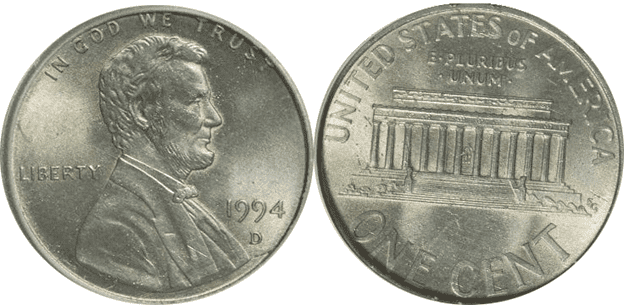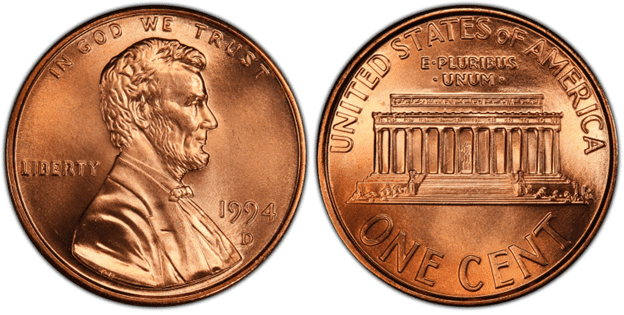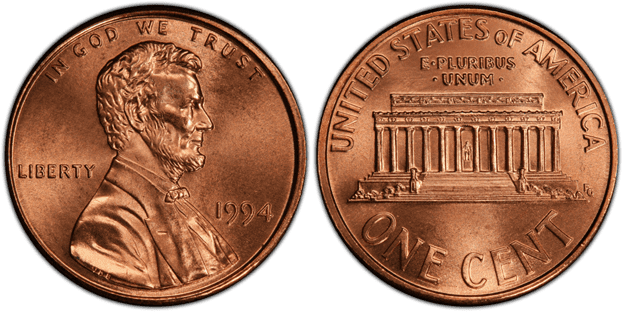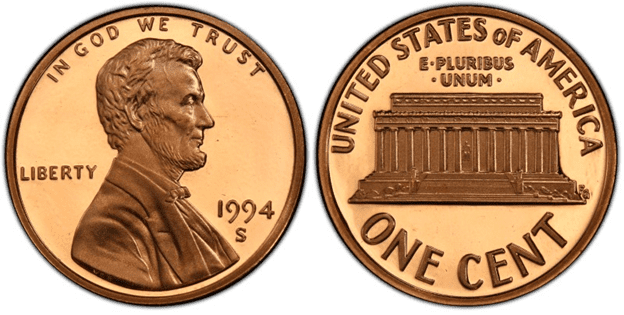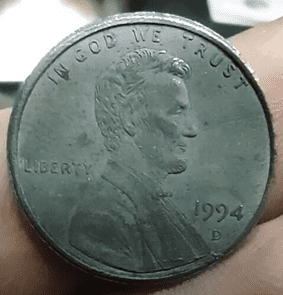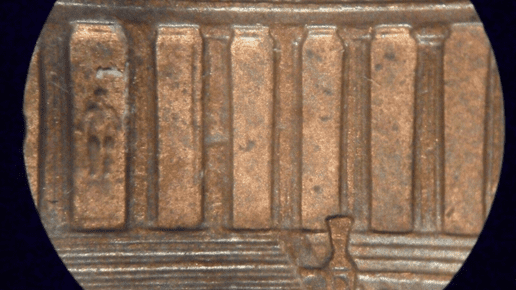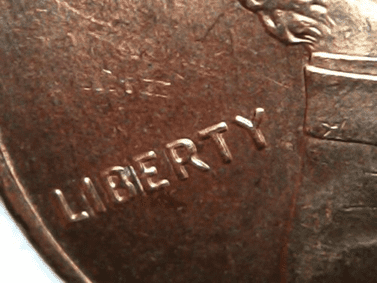What Is the 1994 Lincoln Penny Made Of?
The 1944 Lincoln penny is a copper-plated coin with 97.5% zinc and 2.5% copper. The composition of the Lincoln penny changed over time. Just to give you an idea, here’s how it evolved:
- Zinc plated steel – 1943
- 95% copper and 5% tin or zinc – from 1909 to 1942 and from 1944 to 1982
Then from 1982 until the present time, the Lincoln penny has its current composition of zinc and copper.
The Lincoln penny was first struck in 1909, which is also the centennial birth year of Abraham Lincoln, the 16th president of the United States.
The history of the Lincoln penny is quite interesting. It was in 1904 that President Theodore Roosevelt asked the Secretary of the Treasury, which at that time was Leslie Mortier Shaw, to change the look of U.S. coins. That’s when Shaw hired Augustus Saint-Gaudens to produce new designs. There were different designs made and applied to the coins.
However, it was only in 1907 that Roosevelt turned his attention to the cent. Because the centennial birth of Abraham Lincoln is coming, more and more people would like to honor him and one of the best ways they come up with is to add him to the cent or penny coin.
Thus, in 1908, Roosevelt chose Victor David Brenner to redesign the penny and add Lincoln.

photo source: Coin HelpU
So, when it comes to design, the obverse has the image of Abraham Lincoln facing to the right. Inscriptions include the following:
- IN GOD WE TRUST
- LIBERTY
- 1994
- Mint mark (if present)
On the reverse, you’ll find the front view of the Lincoln Memorial. This was designed by Frank Gasparro. The inscriptions include the following:
- UNITED STATES oF AMERICA
- ONE CENT
- E PLURIBUS UNUM
For the specifications, the 1994 Lincoln penny has a plain edge, a weight of 2.50 gram, and a diameter of 19 mm.
1994 Lincoln Penny Varieties
1994 Lincoln pennies come in different varieties. The main difference is where they are struck and what mint mark they have. In 1994, the US Mint produced official Lincoln pennies from Philadelphia, Denver, and San Francisco.
Aside from the standard coins, there are also coins that were made with errors. As a result, they became a different variety.
Here are some of the best 1994 Lincoln penny varieties that you might want to know:
1994 D Lincoln Penny
Year of minting: 1994
Mint Mark: D
Place of minting: Denver
Quantity produced: 4,448,673,300
Face Value: $0.01 (one cent)
Price: $0.01 to $1.00 (or more)
Mass: 2.5 grams
Edge: Plain
Designer: Victor D. Brenner (obverse) / Frank Gasparro (reverse)
Composition: 97.5% zinc and 2.5% copper
Diameter: 19.05 mm
Thickness: 1.52 mm

photo source: PCGS
The Denver Mint produced the most number of 1994 pennies with 4,448,673,300 coins produced. These pennies have the D mint mark and you can sell or buy them starting $0.01 up to $1.00. Of course, if you have a rare 1994-D Lincoln cent in good condition, you’ll be able to sell them for a higher price.
1994 P Lincoln Penny
Year of minting: 1994
Mint Mark: None
Place of minting: Philadelphia
Quantity produced: 6,500,850,000
Face Value: $0.01 (one cent)
Price: $0.01 to $1.00 (or more)
Mass: 2.5 grams
Edge: Plain
Designer: Victor D. Brenner (obverse) / Frank Gasparro (reverse)
Composition: 97.5% zinc and 2.5% copper
Diameter: 19.05 mm
Thickness: 1.52 mm

photo source: PCGS
The Philadelphia Mint produced more than 6.5 billion Lincoln pennies in 1994. Traditionally, the Philadelphia Mint doesn’t put a mint mark on the coins they have produced. The usual price is the same as the 1994-D Lincoln penny.
1994 S Lincoln Penny
Year of minting: 1994
Mint Mark: S
Place of minting: San Francisco
Quantity produced: 3,269,923
Face Value: $0.01 (one cent)
Price: $0.01 to $1.00 (or more)
Mass: 2.5 grams
Edge: Plain
Designer: Victor D. Brenner (obverse) / Frank Gasparro (reverse)
Composition: 97.5% zinc and 2.5% copper
Diameter: 19.05 mm
Thickness: 1.52 mm

photo source: PCGS
The San Francisco Mint was able to produce more than 3 million Lincoln pennies in 1994. Obviously, the San Francisco Mint has the least number of Lincoln pennies. The main reason is that they specialize in producing proof coins, which are made for collectors.
It takes more time and energy to produce proof coins. This explains why the San Francisco Mint was only able to manufacture a few million, far fewer than the billions of coins produced in other mint centers.
The 1994-S Lincoln pennies are shinier and more appealing. Each coin uses a special type of planchet. They are also manually cleaned and prepared by hand to ensure that the coins would look beautiful once they leave the mint.
List Of 1994 Lincoln Penny Errors
Because of wear and tear, it is inevitable for coins to receive errors during the minting process. Although errors may sound negative, for collectors, this is one of the most interesting parts of their hobby.
There are different reasons why an error may occur. The error may be due to the die, planchet, and strike. Minting equipment may become less effective over time. With thousands of coins produced each day, any parts of the machine could become faulty, leading to various errors. Aside from that, human errors may also become a contributory factor.
Here’s an example of a Lincoln penny error. In this coin, you’ll see that the mint failed to plate the planchet with copper, making the coin look grayish.

photo source: eBay
A doubled die happens when the coin is struck twice. As a result, there’s a doubling in specific places on the coin. Here’s an example of a doubled die on the reverse (DDR):

photo source: eBay
You can see on the columns of the Lincoln memorial that there are shadow-like lines. This is evidence of a double strike.
Here’s another example of a double strike that caused the word LIBERTY to spell like “LIBIERTY.”

photo source: eBay
How Much Is the 1994 Lincoln Penny Worth Today?
The ordinary 1994 Lincoln penny is as valuable as its face value — $0.01. It’s kind of low. Even the melt value is lower, which is $0.0070. As this might be the case, you can still find 1994 pennies that are worth a few hundred dollars.
Just to give you an idea, here’s a 1994 Lincoln Penny values chart for you to explore:
| Coin | Condition | Grade | Mintage | Value |
| 1994 D Lincoln penny | Circulated/mint | Not graded | 7,131,765,000 | $0.01 to $1.00 |
| 1994 D Lincoln penny | Uncirculated/mint | MS-66 | 7,131,765,000 | $9 to $19 |
| 1994 D Lincoln penny | Uncirculated/mint | MS-67 | 7,131,765,000 | $10 to $21 |
| 1994 D Lincoln penny | Uncirculated/mint | MS-68 | 7,131,765,000 | $29 to $104 |
| 1994 P Lincoln penny | Circulated/mint | Not graded | 6,500,850,000 | $0.01 to $1.00 |
| 1994 P Lincoln penny | Uncirculated/mint | MS-66 | 6,500,850,000 | $6 to $21 |
| 1994 P Lincoln penny | Uncirculated/mint | MS-67 | 6,500,850,000 | $15 to $84 |
| 1994 P Lincoln penny | Uncirculated/mint | MS-68 | 6,500,850,000 | $18 to $235 |
| 1994 S Lincoln penny | Uncirculated/proof | Not graded | 3,269,923 | $0.01 to $1.00 |
| 1994 S Lincoln penny | Uncirculated/proof | PR-68 | 3,269,923 | $8 to $19 |
| 1994 S Lincoln penny | Uncirculated/proof | PR-69 | 3,269,923 | $6 to $18 |
| 1994 S Lincoln penny | Uncirculated/proof | PR-70 | 3,269,923 | $36 to $230 |
How Does The Grading System Work?
The Sheldon Scale is used by numismatists to provide a numerical value to coins. The Sheldon Scale goes from poor (P-1) to perfect mint state (P-1) (MS-70). Coins were originally evaluated using words to reflect their condition (Good, Fair, Excellent, Etc.). Unfortunately, coin collectors and dealers had different ideas about what each of these terms represent.
Professional numismatists joined together in the 1970s and established CoinGrading standards. These numismatists now assign grades at key places on the seventy-point scale, using the most regularly utilized numeric points in conjunction with the original adjective grade. The following are the most common coin grades:
-
-
- (P-1) Poor – Indistinguishable and probably damaged; if used, must have a date and mintmark; otherwise, rather battered.
- (FR-2) Fair – Nearly smooth, but without the damage that a coin graded Poor often possesses. The coin must have enough detail to be identified.
- (G-4) Fair – Inscriptions have merged into the rims in some areas, and important elements have been mostly erased.
- (VG-8) Very Good- A little weathered, but all of the primary design elements are visible, albeit faintly. There is little if any, central detail left.
- (F-12) Good – The item is very worn, yet the wear is even, and the overall design details stand out clearly. Rims are almost completely isolated from the field.
- (VF-20) Very Fine – Moderately weathered, with some finer features still visible. The motto or all letters of LIBERTY are readable. Both sides of the coin have entire rims that are separated from the field.
- (EF-40) Extremely Fine – Gently used; all gadgets are visible, and the most important ones are bold. The finer details are bold and clear, however, light wear may be seen.
- (AU-50) Uncirculated – Slight evidence of wear on the coin’s design’s high points; may have contact marks; eye appeal should be adequate.
- (AU-58) Uncirculated Choice – Slight traces of wear, no severe contact marks, almost full mint shine, and great eye appeal.
- (MS-60) Mint State Basal – Strictly uncirculated; no indication of wear on the coin’s highest points, but an unsightly coin with reduced luster, visible contact marks, hairlines, and other flaws.
- (MS-63) Mint State Acceptable – Uncirculated, but with contact scratches and nicks, little reduced shine, but otherwise appealing appearance. The strike is weak to average.
- (MS-65) Mint State Choice – Uncirculated with great mint shine, very little contact blemishes, and exceptional eye appeal. The strike is unusually severe.
- (MS-68) Mint State Premium Quality – Uncirculated with superb luster, no obvious contact marks to the naked eye, and exceptional eye appeal. The strike is quick and appealing.
- (MS-69) Almost Perfect Mint State – Uncirculated with perfect brilliance, a sharp and appealing strike, and extremely good eye appeal. A near-perfect coin with minor imperfections in the planchet, strike, and contact markings (seen only under 8x magnification).
- (MS-70) Mint State Perfect – Under 8x magnification, there are no tiny imperfections discernible; the strike is crisp, and the coin is perfectly centered on a beautiful planchet. Rarely seen on a coin, this coin is bright and whole, with original luster and exceptional eye appeal.
-
Are There Any Rare 1994 Lincoln Pennies?
Yes, there are rare 1994 Lincoln pennies and these coins are normally the ones with the highest grade. For example, Lincoln pennies with grades higher than MS 65 and PR-68 are considered to be rare because only a few Lincoln pennies have this grade.
Where To Buy Or Sell 1994 Lincoln Penny?
There are a lot of places where you can buy or sell 1994 Lincoln penny. In this digital age, you can easily find them on the Internet. Create an account on Bay, Amazon, Etsy, and Facebook marketplace. These websites allow you to both buy and sell coins.
Aside from online marketplaces, you can get in touch with coin grading service providers such as The Professional Coin Grading Service (PCGS) and The Numismatic Guaranty Corporation (NGC). They can point you in the right direction to where you can buy or sell 1994 Lincoln cents.
Every once in a while, there are auctions that happen. Some of the best coins are offered in auction houses. So, be sure to check them out, too.
Coin and antique shops can also be a good choice. You can get in touch with fellow coin collectors. Check their clubs and they might be interested in selling you their 1994 Lincoln pennies.
FAQs
Is there any 1994 penny with no mint mark that is worth a fortune?
Yes, the 1994-P Lincoln pennies with a grade of at least MS-67 should be worth a lot of money. Normally, Lincoln pennies from the Philadelphia Mint don’t have a mint mark.
How many errors does the 1994 D Lincoln penny have?
There’s no official count of how many errors there are for the 1994 D Lincoln penny. However, you can be sure that there are a few error coins that were struck and issued.
Are there any special 1994 pennies?
Yes, the special 1994 pennies are those coins with a grade of at least MS-67 and PR-68. Not a lot of 1994 pennies receive a grade this high. So, if you have a penny with MS-67 and PR-68 and above, then you can say that you have a special 1994 Lincoln cent.

